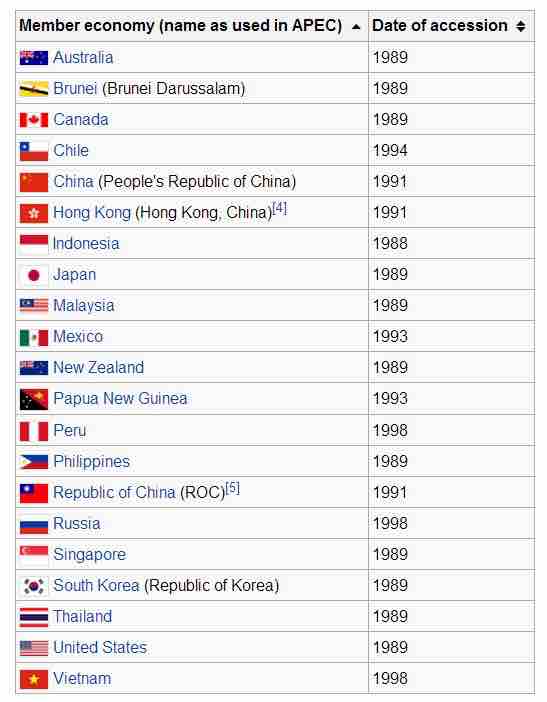Asia-Pacific Economic Cooperation (APEC) is a forum of 21 Pacific Rim countries that seeks to promote free trade and economic cooperation throughout the Asia-Pacific region. APEC includes newly industrialized economies and its members account for approximately 40% of the world's population, approximately 54% of the world's gross domestic product and about 44% of world trade. APEC currently has 21 members, including most countries with a coastline on the Pacific Ocean. However, the criterion for membership is that the member is a separate economy, rather than a state. As a result, APEC uses the term member economies rather than member countries to refer to its members.

APEC's 21 Members
APEC's 21 members have a Pacific Coastline and a separate economy.
Reasons for Establishment
- Established in 1989 in response to the growing interdependence of Asia-Pacific economies and the advent of regional trade blocs in other parts of the world.
- In response to fears that highly industrialized Japan would come to dominate economic activity in the Asia-Pacific region.
- To establish new markets for agricultural products and raw materials beyond Europe (where demand had been declining).
Goals
During a meeting in 1994 in Bogor, Indonesia, APEC leaders adopted the Bogor Goals that aim for free and open trade and investment in the Asia-Pacific by 2010 for industrialized economies and by 2020 for developing economies. In 1995, APEC established a business advisory body named the APEC Business Advisory Council (ABAC), composed of three business executives from each member economy.
APEC works to raise living standards and education levels through sustainable economic growth and to foster a sense of community and an appreciation of shared interests among Asia-Pacific countries.
APEC carries out work in three main areas:
- Trade and Investment Liberalization: According to the organization, when APEC was established in 1989, average trade barriers in the region stood at 16.9 percent, but was reduced to 5.5% in 2004.
- Business Facilitation: Between 2002 and 2006 the costs of business transactions across the region was reduced by 6%, thanks to the APEC Trade Facilitation Action Plan (TFAPI). According to a 2008 research brief published by the World Bank as part of its Trade Costs and Facilitation Project, increasing transparency in the region's trading system is critical if APEC is to meet its Bogor Goal targets. The APEC Business Travel Card, a travel document for visa-free business travel within the region is one of the concrete measures to facilitate business.
- Economic and Technical Cooperation: APEC is considering the prospects and options for a Free Trade Area of the Asia-Pacific (FTAAP), which would include all APEC member economies. Since 2006, the APEC Business Advisory Council, promoting the theory that a free trade area has the best chance of converging the member nations and ensuring stable economic growth under free trade, has lobbied for the creation of a high-level task force to study and develop a plan for a free trade area.
Criticism
APEC has been criticized for failing to clearly define itself or serve a useful purpose. According to the organization, it is "the premier forum for facilitating economic growth, cooperation, trade and investment in the Asia-Pacific region" established to "further enhance economic growth and prosperity for the region and to strengthen the Asia-Pacific community". However, whether it has accomplished anything constructive remains debatable, especially from the viewpoints of European countries that cannot be part of APEC.